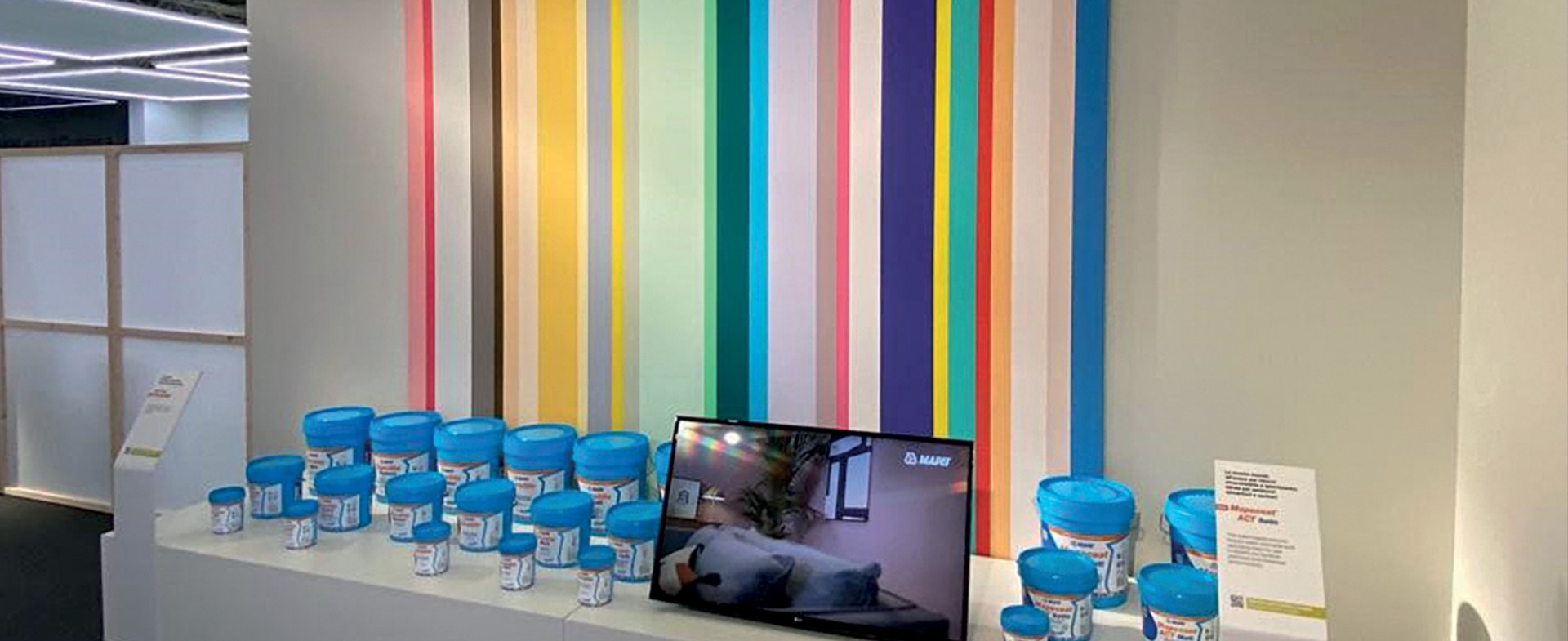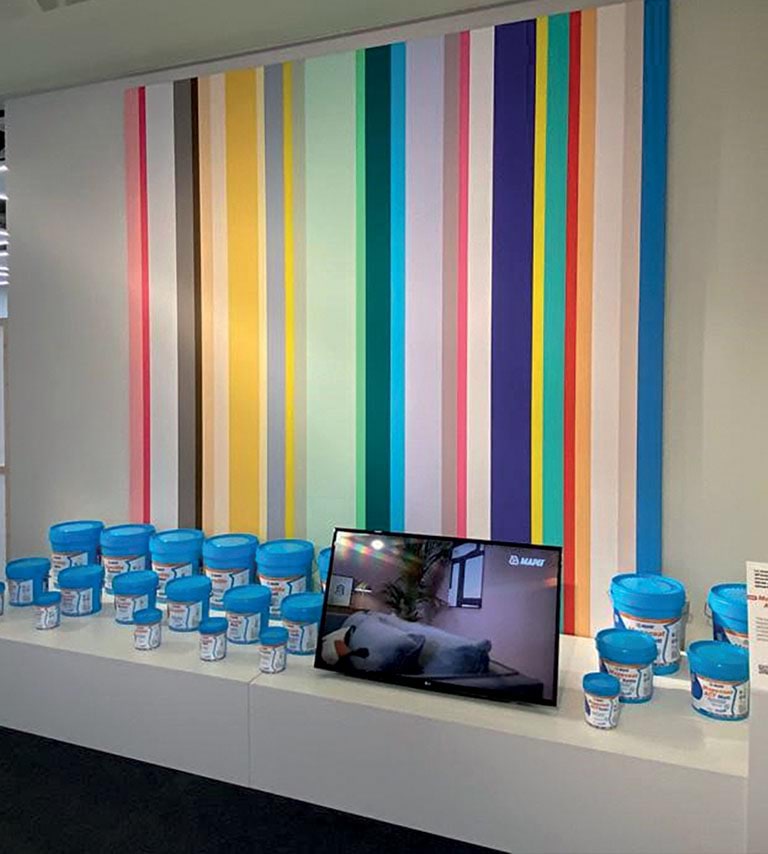The expert's opinion
Stefano Deri
Corporate Product Manager, Wall Coating Line, Mapei Group
The areas of use of Mapei coating range from residential construction to infrastructure, to the redevelopment of existing buildings
Silexcolor, mineral paint for unalterable exterior surfaces: this product is still part of the product portfolio – albeit with inevitable adjustments to its formula – and kicked off the Mapei story back in 1937. The first products launched by the newly founded company were paints aimed at the building sector and their names are still in use to this day: Quarzolite, Dursilite, Colorite and Antipluviol. Over the course of the following years Mapei developed numerous other product lines and the coating line was partially left to one side until 2000, when it was decided to develop a more modern, dedicated line starting precisely from those historic products. In the last twenty years the range of paint products has been extended considerably and now also includes products for external thermal insulation systems, while maintaining its position as complementary products for the rest of the Mapei range. By paint product we generally mean a liquid substance which, once applied on a surface, forms an adherent, seamless layer with two main properties: to protect and decorate the element. Paint products may be classified according to numerous parameters: in Mapei we refer to their area of use, that is, the building sector. Within this sector there are numerous types of application with characteristics that can also differ quite considerably which may be categorised, for example, into modern and historic buildings, residential/commercial buildings and infrastructures, new builds and buildings under renovation. And for all these areas of use Mapei has a suitable cycle of coating products that comply with the highest quality standards, backed up by product and performance certification issued by independent laboratories.

In 2008 Mapei opened a facility dedicated to the production of wall coatings within the Group’s manufacturing complex located in Robbiano di Mediglia, near Milan. The facility was later extended in 2023.
Sustainability: a fundamental driver
Just like all our other products, the two main drivers behind Mapei paint products are sustainability and innovation. When formulating the products, it was decided not to use components that would be harmful to the environment and people’s health and maintain high performance properties while complying with ever more stringent legislation. The formulations were optimised to minimise the emission of volatile organic compounds (VOC), obtaining the highest level in the French classification system for internal products, A+, which guarantees the quality of the air breathed in by both professional painters and end users, thereby ensuring a high level of living comfort. What is more, the impact our products have on the environment has been calculated using LCA (Life Cycle Assessment) methods in order to design increasingly sustainable water-based paints. Their impact is declared on EPDs (Environmental Product Declaration), environmental documents certified by independent bodies.
The current range is made up of three product families: coatings for internal applications and enamel paints, finishes to protect and decorate façades and external thermal insulation systems. The products are supported by a series of marketing tools, the primary being colour fans and cards that are regularly reviewed and updated according to the latest colour trends. In so doing, the ColorMap automatic colouring system also remains constantly updated and optimised to offer the best user experience to our customers. Tinting equipment has also evolved over the years and the systems currently used, with their modular and scalable offer, meet all the requirements in terms of volume and quality of service in the most well-equipped retailers.
The current range is made up of three product families: coatings for internal applications and enamel paints, finishes to protect and decorate façades and external thermal insulation systems.
Water-based paints for interiors
Mapei products for internal applications, the so-called water-based paints, recently underwent a radical overhaul which introduced a number of changes to the product range regarding their formats, packaging and the range of colours on offer. It was also decided to opt for recycled packaging, certified by the Italian Institute for the Promotion of Recycled Plastics (IPPR): all packaging now carries the “Plastica Seconda Vita” (Plastic Second Life) symbol to make the materials made from recycled plastic waste immediately recognisable, an approach recognised by Accredia, the Italian accreditation body.
The new products added to the range are tied to two distinct market trends and comply with well-defined requirements of clients. On the one side, to meet the demand for products that contrast the formation of mould and, on the other side, to offer solutions for construction trends whereby drywall systems are playing an increasingly important role. The two products are admixed with a component that contrasts the formation of mould on walls, an increasingly common requirement in modern and renovated buildings with double-glazed windows. The particularly high efficiency of modern doors and windows in terms of airtightness reduces the amount of air exchanged with the outside and, as a result, there can be a build-up of water vapour inside homes, leading to the formation of mould on walls. Also, more and more people are spending more hours indoors due to a greater use of remote working and, as a result, there has been an increase in the formation of water vapour.
Products for internal applications, the so-called water-based paints, recently underwent a radical overhaul which introduced a number of changes
Products for external applications are the fulcrum of the Mapei portfolio and where the concept of product cycle is best illustrated: out of the vast Mapei range aimed at the building sector, paint products for external use complete every existing cycle and have the capacity to overcome problems affecting façades and surfaces that need to withstand all weather conditions and types of use. Apart from the aforementioned Silexcolor, which is used for mineral coating cycles on both historic and modern buildings, the product range is completed with acrylic, acrylic-siloxane, pure siloxane, elastomeric, anti-carbonation and impregnating products. Each technology meets specific needs and guarantees the sustainability of an intervention, in that it remains highly durable over the years.
The current range is complete not only from a technological perspective (protection for the structure), but also from an aesthetic perspective (decorating the structure), thanks to the variety of colours and textures available. As far as colour is concerned, a dedicated study has been carried out, resulting in the new EXtra Colour divided into 45 colour-coded groups each available in 7 shades, for a total of 315 proposals, specifically formulated to have exceptional durability and lightfastness on external surfaces and to optimise formulation costs. These 315 new shades cover the entire colour range, with particular focus on the latest trends and elegant colour matches. Not only colour, but also texture: Mapei products are available in several variants, from paints with a smooth finish to renders with a high build textured finish that guarantee a high level of protection for substrates.

Certified thermal insulation
The Mapei range is completed by a series of external thermal insulation systems on buildings, consisting of adhesive and skimming compounds, both cementitious and in paste form, and coating products that can be integrated with installation accessories (anchors, profiles, fastening elements) and various types of insulating panels. Buildings (with their cooling and heating systems) are responsible for around 40% of CO2 emissions into the environment. To reduce pollution and the dispersion of energy, it is crucial to intervene on a building’s efficiency by installing the right kind of insulation system. The most sustainable energy is the one that is not used and so, when a method is found to reduce a building’s energy requirements, it not only drastically lowers the level of pollution in cities, but also reduces energy bills. And that is without considering that a well-insulated building also leads to improved living comfort and reduces the formation of mould inside homes. External thermal insulation is a crucial step, in that it means interventions may be carried out on existing buildings to increase their thermal efficiency quite significantly. Mapei recently renewed all the ETA certificates covering its insulation systems, certificates issued by an independent body to guarantee perfect compatibility between the various components used in a system and, therefore, its durability over time. Mapei, in line with its global sustainability strategy, is fully committed to contributing even more towards achieving the European objectives defined by the FIT for 55 package (at least 55% reduction in CO2 emissions into the environment by 2050). And this is what is behind our effort to be an increasingly active member of European organisations that deal with the thermal insulation of buildings including the Italian association Cortexa of which I am the President for the three-year period 2023-2025.

The story of Mapei starts precisely with paints: in 1937 Rodolfo Squinzi founded M.A.P.E.I., marking the start of the production of SILEXCOLOR silicatebased paint and the foundation stone for what was to become a world-leading company.











